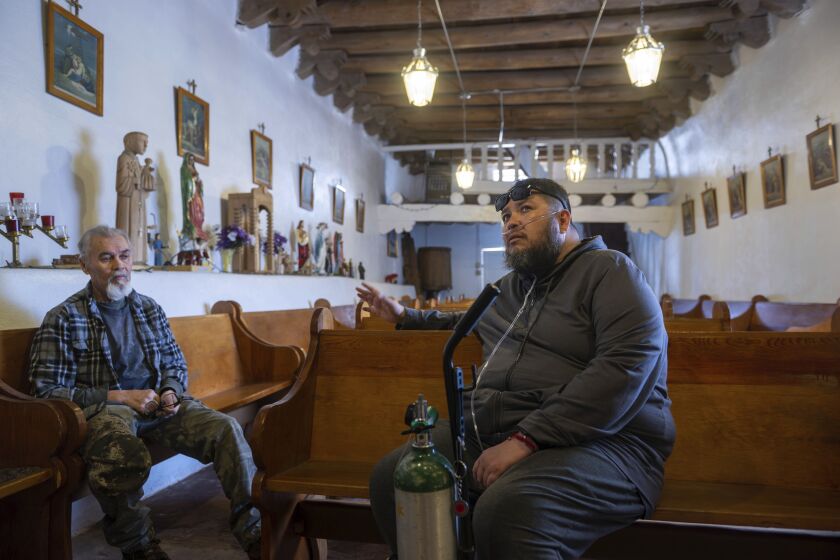HOLMAN, N.M. — On a spring Saturday afternoon, two “hermanos” knelt to pray in the chapel of their Catholic brotherhood of St. Isidore the Farmer, outside this hamlet in a high mountain valley.
Fidel Trujillo and Leo Paul Pacheco’s words resounded in New Mexican Spanish, a unique dialect that evolved through the mixing of medieval Spanish and Indigenous forms. The historic, endangered dialect is as central to these communities as their iconic adobe churches. Its best chance of survival might be through faith, too.
“Prayers sung or recited are our sacred heritage,” said Gabriel Meléndez, a professor emeritus of American studies at the University of New Mexico who’s also an hermano. “When prayers are said in Spanish, they’re stronger. They connect us directly to people who came before us.”
Preserved mostly in devotions, particularly in humble moradas – as the brotherhoods’ chapels are called — built of mud and straw in rural communities across the northern reaches of the state, New Mexican Spanish is different from all other varieties of the language.
“Unlike most other forms of Spanish used in the U.S. today, it’s not due to immigration in the last 100 years but rooted back to the 1500s,” said Israel Sanz-Sánchez, a professor of languages at West Chester University in Pennsylvania who has researched the dialect.
Spanish explorers and missionaries first reached these valleys isolated between mountains, deserts and plains at the end of the 16th century. Pushed back south by the Pueblo Native Americans, they resettled a century later. And their language evolved to incorporate not only words carried from medieval Spain but also a mixture of expressions derived from Mexican Spanish, Native forms and eventually some English after the territory became part of the United States.
Removed from the center of political and economic power for centuries, these villages preserved the dialect orally.
“You never heard English here,” said Felix López of growing up in the 1950s in Truchas, a ridgetop village between Santa Fe and Taos, where this master santero — an artist specializing in devotional art — has been helping preserve the 1760s Holy Mission church.
By the mid-20th century, the push to promote schooling in English led many educators to correct students who used New Mexican Spanish’s idiosyncratic mix of grammar, pronunciation and vocabulary, said Damián Vergara Wilson, a Spanish professor at the University of New Mexico.
He has been working on teaching Spanish not as foreign but as a heritage language that developed into something uniquely New Mexican. It contains some words from medieval Spanish and also includes pronunciations that developed in New Mexico’s villages and words unique to its geographical and historical place at a crossroads of American civilizations. There are several words for turkey, for instance, including an anglicized one used in the context of Thanksgiving.
With such code-switching sometimes disparaged in education and among the public, younger generations often stick to English only or learn contemporary Spanish, especially as spoken in Mexico, with which the state shares a border. That leads many villagers to worry about being able to preserve New Mexican Spanish.
“The dialect we speak is dying out,” said Angelo Sandoval, 45, the mayordomo or caretaker of the 1830s San Antonio Church in Cordova, a village down the valley from Truchas. “We’re the last generation that learned it as a first language.”
Angelo Sandoval,

Angelo Sandoval, mayordomo or lay church caretaker, accompanied by his uncle, santero Jerry Sandoval, inside St. Anthony’s Catholic church in Cordova, New Mexico. Threatened by depopulation, dwindling congregations and fading traditions, faithful like the Sandovals are fighting to save their historic adobe churches and the uniquely New Mexican way of life they represent.
Roberto E. Rosales / AP
Its best chance for survival is prayer. Traditional devotions have been passed down through generations by hermanos, easily memorized because of their ballad-style rhyming. They sometimes are transcribed into notebooks called cuadernos. In an adobe niche in a chapel in Holman, some of the handwritten notebooks are 120 years old.
Even in larger cities, people often request prayers in New Mexican Spanish for special occasions, like rosaries for the deceased or novenas for the holidays.
In Santa Fe, the prayer to the widely venerated statue of Our Lady of Peace contains some of the original Spanish terminology, such as “Sacratisimo Hijo” for the “most holy Son,” said Bernadette Lucero, director, curator and archivist for the Archdiocese of Santa Fe.
In the small town of Bernalillo, where the outskirts of Albuquerque fade into vast mesas, the mayordomos of San Lorenzo also preserve the dialect in their prayers and annual celebrations.
“When we sing an old alabado, we can trace who wrote that,” said Santiago Montoya of the Catholic praise — in Spanish, alabar — hymns that have been passed down through New Mexican brotherhoods.





